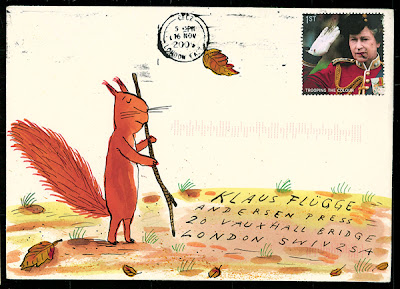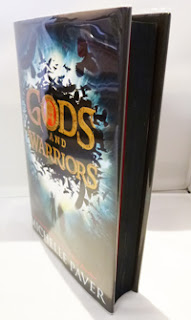Letters to Klaus and The Bookshop Strikes Back
Tomorrow, Saturday 29th June 2013, is Old Town Party day in Banbury AND the start of Independent Booksellers Week 2013 (IBW) and our big Where's Wally hunt around Banbury. Ain't the summertime brilliant?
IBW is great. It celebrates the best of everything independent - and let's face it, isn't being independent so much better than being reliant, or cloned, or unadventurous? Every year publishers bring out a special array of IBW collectibles - specially published books only available from independent bookshops around the country. No really, it's true. Go online (oh, hello, you're online already if you're reading my blog, durr) and check it out - you can only buy these treasures from indies.
I've picked two appealing titles to hone in on this year. I reckon booklovers amongst you are going to love them both.
 |
| Letters to Klaus - front cover |
The first is utterly irresistible. One day 30-odd years ago Klaus Flugge, founder of Andersen Press, had a letter from his friend David McKee which arrived in an envelope illustrated with McKee's distinctive artwork. A trend had begun. As Flugge proudly displayed these illustrated envelopes in his office, more and more came in and were just as proudly added to the display. Letters to Klaus - no, it's not another Christmassy book I promise - is a compilation of 100 of these wonderful envelopes. Feast your eyes on previously unseen art by David McKee, Tony Ross, Ralph Steadman - gosh it sounds like I'm name-dropping here - Susan Varley, Fulvio Testa, Axel Scheffler, Chris Riddell - shall I tempt you with some more?... - Philippe Dupasquier, Satoshi Kitamura, Posy Simmonds, Max Velthuijs...
 | |
| Axel Scheffler - Letter to Klaus |
I haven't seen a proper hand-written letter for years so this book delights me on many levels: the art of letter writing isn't dead, yay!, that's one; the art of producing beautiful illustrated books isn't dead either, huzzah!; indie booksellers get the sole opportunity of spreading the word about this wonderful book; and, and, and all the proceeds from the sale of this book go to Save the Children. It's got to be a winner! Klaus agrees that the printed book is under challenge from other media at the moment but goes on to say that he hopes and believes, '...that picture books will continue to be enjoyed and shared for many generations to come.' Well, if they're all as lovely as this one, that shouldn't prove to be too challenging.
The second IBW collectible I've chosen, well it had to be done; it's Ann Patchett's little essay The Bookshop Strikes Back.
 |
| Ann Patchett - The Bookshop Strikes Back |
Who better to champion the indie bookshop and the future of the printed book than author AND independent bookshop owner Ann Patchett:
'If what a bookstore offers matters to you, then shop at a bookstore. If you feel that the experience of reading a book is valuable, then read the book. This is how we change the world: we grab hold of it. We change ourselves.' (p.20)It's a little essay so I'm not going to tell you all about it! Needless to say it's a heartwarming and optimistic read. In 2011 Ann Patchett bucked the trend and opened an independent bookstore in Nashville, Tennessee. Disappointed to wake up one morning and find that her city no longer had a bookshop - not a chain, nothing - Ann slowly came around to the idea of doing something about it. Parnassus books is now a roaring success and it's on my 'must see if I ever take a world tour of fabulous bookshops' list.
It's just a little essay, it's really good, it's only going to cost you £1.99 - and by buying it you're supporting an independent bookshop and helping them to stay open. Go on. I think you'll enjoy it.
They are both lovely little books. Since it's Independent Booksellers Week it's time to give my bookshop a plug and to let you know that I have limited stocks available of both of these titles. They're only available in the shop, or you can email if you'd like us to reserve copies for you. Letters to Klaus is £6.99 and all proceeds go to Save the Children.






















